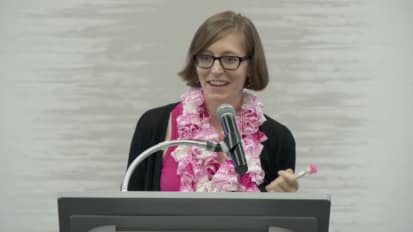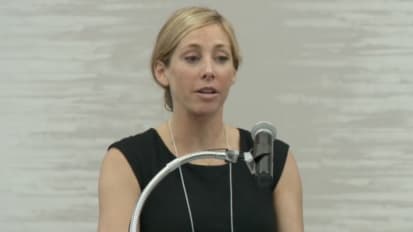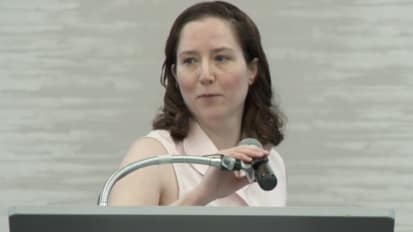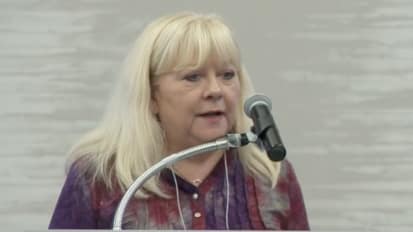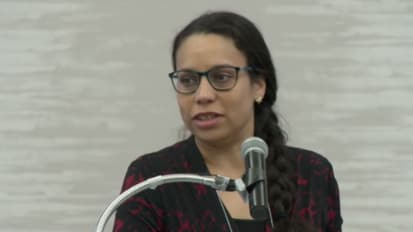Chapters
Transcript
THUY VU: When we're talking about hereditary breast cancer, the BRCA1 and 2 genes always come to mind, but technology has changed a lot. And so in the last five years, more advanced genetic testing technology has become available, where we are now offering multigene panel testing or next gen sequencing tests. And so if you see any patients who-- and you screen for breast cancer, you're an OB-GYN, you have a female patient population, or you treat patients with breast cancer, lab representatives may have visited your office at any point in the last few years to discuss the availability of these gene testing.
So I just kind of want to take and review with you my experience in terms of how that panel testing has impacted my practice and what kind of information and questions that are arising with our patients here. Just go next. OK. So I'm going to be discussing about a lot of different labs, and I have no financial interest with any of them.
So I'd like to review with you just what next gen sequencing can tell us, and what it does, and then just go through with case reviews to go over different types of results and what kind of situations and questions arise. And so you know, this slide is very familiar everybody, but 5% to 10% of breast cancers are inherited. And these families have a susceptibility to a high risk gene mutation. So the vast majority of patients with breast cancer, even if there is a weak family history, there's no reason why we need to worry about genetic or risk inheritance at all. But in these families that have hereditary risk, you're going to see a consistent pattern of multiple generations with breast cancer, multiple people in each generation, and typically younger age of onset.
So pre-menopausal onset of breast cancer, bilateral disease at any age, but when they're bilateral disease, they're more enriched for having a mutation if their first cancer was actually before 50. And so when we break this down, this table was actually created in 1998 and it still pretty much holds true. So the majority of families that have a genetic susceptibility to breast cancer, they're going to be found in the BRCA1 and BRCA2 genes. Majority of families will have mutations in the BRCA1 gene.
And then there are still families where I would put money down that they have some kind of genetic susceptibility. They meet that three, two, one criteria. Three relatives over two successive generations, at least one person before 50 diagnosed, and their BRCA testing is negative.
So you know, we're not as smart as we think we are. And so there are other genetic causes that explain these family histories, and it was a matter of just improving our testing technology, improving our knowledge, thinking about these tumor suppressor DNA repair pathways, and really figuring that out.
So this would not be a talk about hereditary breast cancer if I didn't give you at least one slide review about the BRCA1 and 2 genes. So there are very subtle differences that we've learned over a 20 year history of testing of the BRCA1 and BRCA2 genes. And so the genes were identified in 1994 and 1995, and in clinical testing pretty much became available overnight.
And what we've learned is that in families that have BRCA1 gene mutations, 60% to 80% of women who present with breast cancer often have triple negative disease. And because most women with BRCA mutation in general are younger onset with their disease, the NCCN guidelines were updated-- I think it was 2011, 2012-- they basically said if you have a patient who's diagnosed with triple negative breast cancer before age 60, they should be offered BRCA gene testing regardless of family history. The risk of ovarian cancer is much higher for women with a BRCA1 as compared to BRCA2. The risk of male breast cancer we see mostly with BRCA2 families, but they have been reported in BRCA1 families as well. And then, we've learned a lot about prostate cancer, actually, with the BRCA genes.
So we've learned that these men tend to be younger onset, typically under 55 or younger. They tend to have a much higher Gleason score, so Gleason 7, 8, or 9 grade to their prostate cancer. And Medicare, actually, for the longest time, they only covered BRCA1 and 2 gene testing for women who had breast cancer, ovarian cancer history.
And I think it was last year or this year, for sure, but their guidelines were updated. That if you have a man with a Gleason 8 or higher prostate cancer-- doesn't matter his age of diagnosis-- Gleason 8 or higher prostate cancer, with a family history of a breast cancer under 50 or any age ovarian cancer, Medicare will cover his genetic testing. Because the data for a BRCA mutation in those men is rather compelling. It's up to 20% will have a mutation.
And then we've studied pancreas cancer and the setting of BRCA, and we see that it's clustered more in BRCA2 families. But globally, most of your families with BRCA mutations, you're not going to encounter pancreas cancer in them. So the guidelines don't generally support routine pancreas surveillance for these families, but certainly be aware of family history.
So this is just a timeline of the BRCA gene testing. With a 20 year history, a lot of the technology has evolved. A lot of the testing and the gene analysis has changed.
So when I have patients newly diagnosed with breast cancer today and she tells me, oh, I had BRCA testing or someone in my family had BRCA testing years ago, I encourage them to get a copy of that relative's test report, because it matters. Because, let's see-- OK. So in 1990-- hold on. So Myriad acquired the patents for the BRCA genes in '95 and '96, and then they basically became the sole lab in the United States to offer the BRCA gene testing.
In 2006 they offered an updated analysis. And so initially, it was just full sequence analysis of BRCA1 and BRCA2 genes, and then in 2001 they added a panel of five site large rearrangements that were found only in BRCA1 gene. And then it was in 2006 they offered a test called BART, and it stood for BRCA Analysis Re-arrangement Test. So it's full, comprehensive large rearrangements analysis of both BRCA1 and BRCA2 genes. That was available in 2006, but most insurance companies were not covering it until 2010, even 2011.
And so if I had a family that said, oh, it's a really strong family history and they had negative BRCA testing, even if they had it done in 2010, it may not have been the full comprehensive analysis. And large rearrangements in the BRCA1 or 2 genes are expected to account for 6% to 10% of BRCA mutations. So it's not a small capture, but it can be significant for those families in which we find mutations.
So aside to just the genetic testing, was that in 2009, the ACLU basically sued Myriad, the US patent office, and the University of Utah, and they said you can't patent genes. That worked all the way up to the Supreme Court in a remarkably fast timeline. And in June of 2013, the Supreme Court basically ruled that genes are not patentable. They're products of nature, you can't patent this.
The very next day, at least five labs started offering BRCA gene testing, so they were anticipating this ruling. And these labs were some I'd never heard of. There are other labs where they'd offer everything but BRCA testing on their cancer testing menu, and so finally they're able to sort of fulfill, have a more comprehensive menu.
And so in the midst of all of this, in 2010, the physician scientists who discover the BRCA genes, Dr. Mary Claire King at the University of Washington, she has been studying the BRCA genes and like the '80s. And she continued to study these families, despite families having negative BRCA mutations. And over the years and research efforts, she found mutations in other genes, through her lab and through other international collaborations. But these other genes that were identified, they weren't developed into clinical tests that were marketed to providers or genetic specialists, because they didn't account for the bulk of hereditary breast cancer families like the BRCA1 and 2 genes were. So it just wasn't financially feasible for labs to really invest that effort.
But Dr. King used next-generation sequencing technology, and she basically built a chip, more or less, and added all of these other breast cancer, ovarian cancer genes on this chip, in which mutations had been found. And as a proof of concept, a paper, but she basically said, OK, using next gen sequencing I analyzed, in parallel, 17 breast ovarian cancer genes, and this technology detected mutations in every single one of these families that Sanger sequencing, the old school way of testing, found. And so the University of Washington lab was the first lab to offer commercial next gen sequencing panel test for hereditary breast cancer.
In 2011, they published a great paper. It was all comers, ovarian cancer, regardless of family history, and they tested them for 21 breast and ovarian cancer genes. And they found that up to 24% of families had a BRCA1 or BRCA2 mutation, in addition to other gene mutations.
So of those 24%, the majority were in the BRCA1 and 2 genes. Like 17% were in the BRCA1 and 2 genes. The other percentage of patients that had mutations found, they were in these other genes.
And so that really demonstrated that it is worthwhile to analyze these other genes. And using new technology, we can do it in a very efficient and cost effective manner. They estimated that their test would be $1,500 to analyze 21 genes, whereas at the time Myriad was charging almost $4000 to analyze two genes. So that was in 2011, and pretty much gradually over 2011 to 2013, other labs, other commercial labs, started looking at these other genes, these lesser known breast ovarian cancer susceptibility genes, and put them all into a panel test. And that's kind of where we are today.
So now that we have a quick rundown of just next gen sequencing and kind of the current state of genetic testing and the history of it, I'm just going to go over some pedigrees. So just to kind of let you all know, women are drawn as circles, men are drawn as squares.
This is a 46-year-old woman, presented with an ER/PR negative right breast cancer. She's Ashkenazi Jewish. Her father died of pancreas cancer, aunt died of ovarian cancer, an aunt had breast cancer at 35, and that woman's daughter is 40, newly diagnosed with breast cancer. What would you offer this woman? What would you guess she has?
Yeah? So in her case-- there's too many buttons! Yes, OK.
So the mutation that she has is a very classic Ashkenazi Jewish founder mutation. And so in cities where there's a high Jewish population, we specifically ask if the families are of Ashkenazi Jewish descent, because they have a 1 in 40 chance of actually curing a BRCA mutation. That's 2.2% without knowing any family history, whereas in the general population, non-Jewish, it's more like 1 in 400 to 1 in 800 individuals.
And so obviously she tested positive and her cousin tested positive, and so now we're thinking about what to do with her kids and helping other family members navigate this. So this is why I get to spend-- I have 60 minute consultation visits with patients. But once a patient is scheduled for genetic consultation, they're mailed a family history questionnaire. So they can sort of open the family Bible, call their mom, call their aunts, and record all this information, make those phone calls, and clarify these cancers, and bring it in for a more detailed succinct visit with me.
And so just to orient you, this is a family in which there are nine siblings, and they're all in their 70s to 89-years-old. But there are two men here diagnosed with breast cancer, and they both had bilateral disease. So what does that scream to you? Genetic, right?
The sister here, she had non-Hodgkin's lymphoma at 71, breast cancer at 76. A sister here had breast cancer at 42, recurred at 45, colon cancer at 59, and she died at 62 from metastatic disease. And then in the family here, dad had prostate cancer at 76. Mom had a through cancer at 68. Some lung cancers up here.
So these men lived in Canada, and they pursued BRCA gene testing, and this was back in 2005, 2006, and he was found to have a variant of uncertain significance in the BRCA2 gene. His brother lived in a different province in Canada, but had the same testing done, and he had the same BRCA2 variant. The plot thickens, right.
This sister had already passed away at the time, she died in the 80's, and so the genes weren't even known at the time. But this sister here who had breast cancer, she tested negative for that BRCA2 variant. Yeah.
And so my patient is the woman down here, the baby sister of the family, who's 75, a vibrant woman. And she's worried about this family history, and she wants to sort this out. Because she's got intact breasts, and she's got a daughter and granddaughters that she's worried about, not to mention all these young nieces here.
So with the variant detected, there's not much that we-- a variant basically says there is no known clinical significance to the cancer. And in this family, the variant's clearly not tracking with the breast cancers in the family. And so they've exhausted their BRCA1 and 2 gene analysis. This is a great family in which you would consider next gen sequencing and analyzing further for these other BRCA breast ovarian cancer genes.
And so that's what I punted to these brothers here, to go back and consider doing that testing. This is kind of what my breast surgery team has kind of proposed to me, requested specifically that I address in this presentation. But with all the different panels that are out there, and these labs, and they offer five gene versus 15 genes versus 25 genes, it gets a little overwhelming. And so how does a genetics specialist like myself make the choice to go with one lab over the other, and do I use the seven panel test, or the 17 panel test?
There is a great review through ASCO University, actually that's the PubMed ID, and it's a really short summary about panel testing, and sort of a really good primer for providers, and just kind of pros and cons and things to think about. So if you have questions yourself, I think that's a great reference to go to. But really, considerations, right? So think about what disease you're worried about and what are these genes on there.
For me, I focused a lot on the billing and the cost issue, because that's what the patient's primary concern is. And so how easy is the lab willing to work with the patient. Do they offer financial assistance, what is the patient's out-of-pocket cost, all these billing policies.
And then as a provider, I know a lot about these genes, but there's a lot of genes out there that I'm just really not that familiar with. So how easy are these labs to work with? And if I have questions about a gene, how accessible are they, or if a variant comes up? How accessible is that information and how willing do they share all of that information?
And then the other thing to think about is how do they handle variants and informatics. They're analyzing all this data, all this information, what do they do with it all, and how do they share that information? And so this is from that ASCO University paper, here.
So BRCA1 and 2 is up here. These are the Lynch syndrome genes. Lynch syndrome is the second most common cause of hereditary ovarian cancer. Cowden syndrome, Peutz-Jeghers, Li-Fraumini, and a lot of these genes down here are genes involved in the BRCA DNA repair pathway. So they either directly interact with BRCA1 or 2, or they're part of that whole homologous recombination DNA repair pathway. So it makes sense that the phenotype would look similar, if any part of that pathways is impaired.
But Ambry Genetics, they offer a 9 gene panel for just ovarian uterine cancer, or a more advanced. OvaNext panel has 24 breast ovarian, all these other genes. Baylor College of Medicine is in the game.
Color Genomics-- this is a company and the Bay Area, and they have a plan where it's just $250. They don't bill insurance, it's all direct patient bill. But you basically provide only a saliva sample. They don't have to have people verify insurance, because the patient's paying that $250. It has to be ordered by a provider, but they use next gen sequencing technology.
So that's a great option that I offer patients, who I know insurance-- they don't meet insurance criteria. Because that $250 is generally a little bit more if not close to what a lot of patients with insurance coverage are actually paying for the test. Gene DX, they've been involved in genetic testing for cancer syndrome for a long time. They have a uterine cancer panel that's 12 genes, a more advanced breast ovarian panel.
And then University of Washington, their Broca test, named after the pathologist Paul Broca. It initially started in 2011 as a 40 gene and now it's 61 genes. And their genes cover Von Hippel-Lindau, kidney cancer, colon cancer, melanoma, kind of a whole wide spectrum.
So when you dig into multigene panel testing, figure out well, how much more information am I actually getting? Do I want just the breast ovarian genes? You know, but these panels, they tend to add a little bit more. Because if there's any weak data that breast cancer might be associated with that disease, they're going to add that to this panel.
Various labs have gone over their experience into finding mutations, and also their variant rates. So when we add more genes, particularly newer genes, where we have less data, you're going to get a higher variant of unknown significance rate. The BRCA1 and 2 variant rate is about 2% be 3%. But when you're testing for these other genes, they can be as high as 40%.
This one here showed that individuals of Hispanic, African-American, and Asian descent had much higher variant rates compared to someone who was Caucasian. And then the more genes that you have in the panel, the higher your pick-up rate, makes sense, for finding a mutation. But then you also have a much higher rate of having a variant detected. So this is like 120 gene panel testing, and they had 80% of tests were found to have a variant. That's pretty high.
And just one [INAUDIBLE] data about their variant rates. So like colon cancer, there aren't a lot of newer colon cancer genes being found, so they have the lowest rate, because most of these genes are well established and well studied. Whereas the cancer panel has a lot of the newer breast, ovarian, and some pancreas and melanoma genes, and that has a much higher variant rate there.
So in general, I don't get excited about variants. They're called variants of unknown significance for a reason. There's just not sufficient evidence or conflicting evidence for the lab to definitively call it as causing cancer risk, or just normal variation. The labs continue to update their databases on these variants, and most of them will automatically notify the provider when variants get reclassified. And I'll tell you that 80% to 90% of the time, variants get reclassified and they get downgraded to benign polymorphisms.
So based on that statistic alone, I don't get excited about it and I don't tell patients to test other relatives or inform family members at all. But the one thing is that I encourage them to enroll in registries, either through Mayo Clinic or some of these bigger, older hereditary cancer programs. But this PROMPT registry arose basically out of next gen sequencing testing.
So it's a consortium of academic institutions, and they basically said OK, patients, go online, submit us your information and the variant that you have, and in the future if a researcher wants to study your variant, they can submit a protocol to PROMPT registry. And the PROMPT will query the number of patients that meet that, and they'll just notify you that there's this research opportunity. So it doesn't obligate patients to participate in research, but at least puts them in the loop to hearing and knowing more about it.
And the key with all of this is to really have the labs pool their data together. Because if you're sitting on a rare variant here, and another lab's sitting on a variant here, that's not going to go anywhere, right. So you want to pull altogether and really increase your n to make statistical significance with these efforts.
All right, so here are some more pedigrees here. 45-Year-old with carcinoma in situ. In her paternal family, an aunt had breast cancer at 42, had brain and lung cancer, so I think there was metastatic disease. And then her maternal grandmother died at 41 from breast cancer. And an aunt here had liver cancer at 48.
So she's got a bilineal family history, right, but there's just one affected relative on each side, and both of these women are deceased. I offered her one of these panel tests, and she was found in mutation the PMS2 gene, which is not a classic breast ovarian cancer gene. It's associated with Lynch syndrome. Lynch syndrome is the most common cause of hereditary colorectal and uterine cancer, and it's the second most common cause of ovarian cancer.
And so where is the colon, the uterine cancer in her family here? So what we know about Lynch syndrome-- sorry, PMS2 specifically, is that these women or these individuals have 15% to 20%, so a much lower penetrance of colorectal and uterine cancer. So it makes sense that you may live to 70 and not getting colon or uterine cancer, right. But nowhere on this NCCN table is breast cancer listed.
So then there is a review that was done in 2013 looking at all the breast cancer histories associated with Lynch syndrome. And they found a few key studies. This was a prospective study, the only one that was done, and it was an international collaboration of more than 400 Lynch syndrome families. And they found that these patients, women with the Lynch mutation, had a four-fold higher risk of breast cancer.
This one, I think it was a bit of an outlier, it's a of 13-fold risk, and this one here is about a two-fold risk. So most of them kind of hovered around no increased risk at all, actually. So based on a few studies where it's like to four-fold increased risk, I think some families with Lynch syndrome have breast cancer as part of their Lynch, but most families will not. So obviously in this particular pedigree, we're going to need to focus on the breast cancer screening and surveillance for this family.
And then the NCCN basically says, "There have been suggestions that there's increased risk, but there's not enough evidence to support increased screening." So in this family where there's only breast cancer and they have this PMS2 gene mutation, you feel compelled that you want to screen her sisters and the other women high risk for breast cancer. But the guidelines don't support that.
So we can always use family history and risk models to estimate breast cancer risk. And if these models, based on estrogen years and family history of breast cancer raises her risk by more than 20%, then she can qualify for breast MRI and get high risk surveillance that way. So it's kind of a roundabout way, but you're using the family history as your guide.
All right, this is a case in which the results may not fully explain the cancers. And so here's a woman with uterine cancer in 2011. It was an endometroid carcinoma. Three years later, she had a total laproscopic hysterectomy for that. BMI was 31. And then three years later, she developed a stage II and endometroid adenocarcinoma left ovary.
Clinically, it was thought to be a separate primary. They did protein staining for the Lynch syndrome gene proteins, and those were intact. So you have a woman who's 43 with a history of ovarian and uterine cancer. Family history is not really strong for anything.
She's got a cousin here with-- is that ovarian cancer? Over here, but through mom and grandmother and aunt here who have no cancer history. Panel testing revealed that she had a mutation in the CHEK2 gene.
So CHEK2 is a gene that is part of the DNA, the BRCA repair pathway. So ATM identifies DNA activates CHEK2, and then initiates a cascade of events for DNA repair and apoptosis. There are several founder mutations now, and the risk of breast cancer is 28% to 37%, and there's a 24% risk of a contralateral breast cancer. And this is an interesting gene, where the type of mutation matters.
So families that have frame shift or truncating mutations tend to have a higher breast cancer risk, more like two-fold, 2.5-fold. Whereas families that have a missense mutation, they have under two-fold risk for breast cancer. And then also the risk for colorectal and prostate cancer appears to be two-fold, but then there's mixed data on whether other cancers may be associated, and ovarian cancer is not associated.
NCCN guidelines have evolved for CHEK2 , so when this came out in 2014, CHEK2 wasn't on their radar, but every year it's kind of been updated. And so right now we focus on increased breast surveillance. We start with imaging at 40. We do not worry about the ovaries, but because of the colon cancer risk, we start colonoscopy at 40 in these families if they have a family history of colon cancer.
And so this one-- this is a gene where you need to really tailor the screening based on the family history. But if you go back to that pedigree I showed you, it doesn't explain her family history. And so is CHEK2 really the answer for this family history, or some people think that CHEK2 actually is a modifier gene, where it interacts with other genes, but we don't know what those other genes or those other risk factors are. So this is a gene that there's just a lot of mixed data on and it's evolving every year. I don't like it.
All right, so here is a family history. 56-Year-old, she's worried about her family history of breast cancer. She had negative BRCA testing in 2010, but it did not include that BART test.
Her mother had breast cancer at 56, two great aunts had breast cancer, and then great grandmother here had breast cancer. In her paternal family, melanoma, breast cancer, and pancreas cancer, following her breast. Pancreas cancer, breast cancer at 45, breast cancer at 48. And she had negative BRCA testing about seven years ago. So clearly there's a lot going on in this side of the family, and there's a little bit of something going on in this family.
So I offered her panel testing, because she did not have full BRCA analysis, and there's just a lot going on. And she's got two mutations, so what do we do about this? So these are genes, both ATM and RAD51C that are involved in that BRCA pathway. And you can see here ATM carries that four-fold increase risk, and RAD51 have breast cancer risk, and this risk of ovarian cancer here.
So in her case, I was not able to figure out-- oh, I was not able to get other relatives to do the genetic testing to figure out where that's coming from. But knowing that the ATM gene is associated with pancreas and breast cancer, I would surmise that this side has the ATM and this side has the RAD51 gene. Where RAD51C-- I'll review this with you. Oh, sorry.
OK, so the ATM gene, it's associated with-- it was actually identified in families with kids that were affected with ataxia telangiectasia. And they noticed that there was a higher prevalence of breast cancer in these children's mom and grandmothers. And so that's kind of what started the study.
And we see that women have a higher risk of breast cancer under age 50, but after 50 it becomes two-fold. The pancreas cancer is increased, but we don't have exact estimates for that yet, and then as far as these other cancers it's unknown. Individuals that have two ATM mutations that have this AT condition, they are sensitive to ionizing radiation. But what women who have just one ATM mutation, it's currently unknown.
So this is a consideration for our radiologists colleagues to think about. Well, we're talking about 3-D mammograms in these women where there is more radiation exposure, you know, what do we do for these women, or do we need to think about breast MRI, where there's no radiation exposure? But they have this higher risk of breast cancer. So these are some questions that I think will evolve with the answers in coming years.
This is a family-- oh, it's another ATM. I'm out of time, so I'm gonna just speed through.
OK, so RAD51 gene is detected in breast and ovarian cancer families. It's actually rare in breast cancer only families, but in families I have breast and ovarian cancer, we found RAD51C mutations. So if you go back to the original pedigree, that woman's maternal family history, there's no ovarian cancer, only breast cancer. And even in her father's family, there was no ovarian cancer either. And so there's still a lot of questions that arise due to these genes, and as far as management for them because the cancer risks are still evolving a lot.
And so the guidelines have evolved a lot. And so in 2015, NCCN said for these women, we should definitely recommend MRI. ATM, BRCA, CHEK2, PALB2 is another BRCA repair pathway gene. But RAD51C and D, we don't recommend addressing their ovaries at all, and we don't recommend discussing mastectomy for ATM or CHEK2 or PALB2 carriers.
In 2013, some of these got moved up here, where RAD51C and D got moved up to, we definitely need to think about taking out their ovaries, here. And then now, we basically say there's still unknown evidence for breast cancer risk, but there is risk of ovarian cancer in these women. And for ATM, we consider risk reducing mastectomy based on family history, and we do screening mammograms starting at 40. So the guidelines change every year. So if you have a woman with one of these newer gene mutations, it's important to kind of check in with the guidelines and update the management for your patient every year.
You know, I mention that family that had the ATM and the RAD51C mutation, so just a quick lit review about families that have two mutations found. We actually don't see that they have higher risk of second cancers at all. There's no difference in age of onset, the breast cancer bilaterality, or the cumulative lifetime risk. And the idea is that once the pathway is broken, it's just broken. You can't beat the car broken any further.
And so they actually don't look any different than other families, and you manage them based on-- I would manage them based on the gene that has a higher cancer risk for the individual. So last pedigree here, we have a woman who is 41 with breast cancer. In her paternal family, uncle had colon cancer, aunt had breast cancer her 30s, survived that. A cousin here had DCIS at 48, and was negative for BRCA genes.
So my patient here did panel testing. I said, gosh, I think there's something here, but that's interesting that she's negative. And she tested positive for a BRCA gene mutation and a CHEK2 mutation. So this is where that pathway is just broken. So we would focus on her, to screen her for just based on BRCA2 guidelines. And we found that her mother has the CHEK2 mutation.
So this is interesting, because then we would presume that the paternal family has a BRCA2 mutation, but this cousin here is negative for BRCA2. So it could be just a phenocopy, a sporadic breast cancer in the context of all of this. So we can't always assume things, and we should test family members. Now that we have all of these fancy genes out there, families that have other breast cancer cases, they should do full testing to really sort this out and vet this out for the unaffected relatives in the family.
So in summary, genetic testing using these big panels is pretty complex. So you really need to think carefully about the types of genes that you're adding. The more genes you add, the more variant results that you're going to get. And if you're OK dealing with that your patient is comfortable with variants or uncertain results, you know, then proceed.
But some patients truly don't like the idea, and they don't like being the guinea pigs, and they'd rather reconsider more testing in the future once more data becomes known about these genes. And the guidelines for management are going to change over the years, so it's important to really check in with NCCN, publications, high risk groups to really update your management guidelines for these patients. All right, thank you.
Thuy Vu, MD, CGC, discusses her topic 'Lessons Learned from 5 Yeas of NGS panel testing for hereditary breast cancer susceptibility'.
Related Videos
